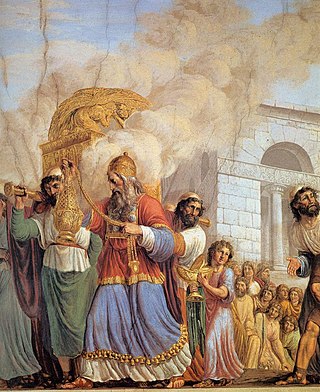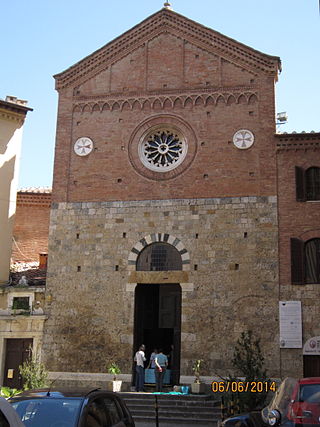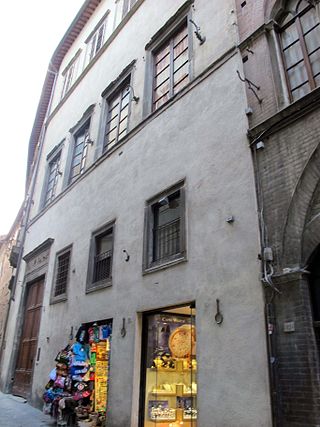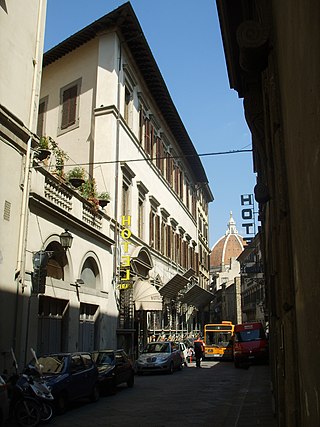
Pinturicchio, or Pintoricchio, also known as Benetto di Biagio or Sordicchio, was an Italian painter during the Renaissance. He acquired his nickname because of his small stature and he used it to sign some of his artworks that were created during the fifteenth and sixteenth centuries.

The Palazzo Pubblico is a palace in Siena, Tuscany, central Italy. Construction began in 1297 to serve as the seat of the Republic of Siena's government, which consisted of the Podestà and Council of Nine, the elected officials who performed executive functions. The palace is of medieval and Gothic architecture, and the interior is lined with frescoes--most importantly, the collection known as The Allegory of Good and Bad Government by Ambrogio Lorenzetti.

Santa Maria della Scala is located in Siena, Italy. Now a museum, it was once an important civic hospital dedicated to caring for abandoned children, the poor, the sick, and pilgrims. Revenues were earned partially from bequests and donations from the citizens of Siena, particularly the wealthy. The head of the hospital was the rector who managed the lay brothers responsible for its operation.

Luigi Ademollo was an Italian painter.

Palazzo del Magnifico, also known as Palazzo Petrucci, built as the residence of Pandolfo Petrucci, is located in Siena on Piazza San Giovanni at the corner of Via dei Pellegrini.

The Palazzo Bichi Ruspoli, or previously Palazzo or Castellare dei Rossi, is an urban palace, located on Via Banchi di Sopra in the present contrada of Civetta, Terzo di Camollia of the city of Siena, region of Tuscany, Italy.

The Palazzo Piccolomini, also known as the Palazzo Todeschini Piccolomini is a Renaissance-style palace in the city of Siena, region of Tuscany, Italy. It is located on the Banchi di Sotto, at the corner with Via Rinaldini; uphill and west of the church of San Martino, the Loggia del Papa, and the Palazzo delle Papesse, which also built by a Piccolomini family member.

The Palazzo Palmieri, or Palazzo Nuti, is a Mannerist style urban palace, located on Via del Moro #48 in the present contrada of Civetta, Terzo di Camollia of the city of Siena, region of Tuscany, Italy.

San Donato, also called San Michele al Monte di San Donato, is a Baroque style, Roman Catholic church located on the Piazza on Via dell'Abbadia, Siena, region of Tuscany, Italy. The Monte de Paschi di Siena, whose original offices were in the Palazzo Salimbeni, whose rear facade faces the church, has a Pinacoteca/Museum called San Donato.

The Palazzo Bindi Sergardi, previously Agostini and later Casini-Casuccini is, from the outside, a non-descript urban building located on Via dei Pellegrini # 18 in central Siena, region of Tuscany, Italy. The site is best known for containing frescoes by the late-Renaissance painter Domenico Beccafumi and Cristoforo Roncalli.

San Niccolò al Carmine, also called Santa Maria del Carmine is a Renaissance style, Roman Catholic church and monastery located in Pian dei Mantellini #30, near the corner of Via della Diana in the Terzo de Citta of Siena, region of Tuscany, Italy. The church now serves as the Oratory for the Contrada of Pantera. Across the street from the belltower is the Palazzo Celsi Pollini. North along Pian dei Mantellini, toward the Arco delle Due Porte, and on the same side of the street are a number of palaces built around what was once the Monastery of the Derelict Women: in order they are the Neoclassical Palazzo Incontri, the Palazzo Ravissa and the Palazzo Segardi.
The Palazzo Sergardi or Sergardi Biringucci is an 18th-century aristocratic palace located on Via Montanini #110 in the city of Siena, region of Tuscany, Italy; the palace is best known for its late 18th century Neoclassical frescoes by Luigi Ademollo.

The Palazzo Celsi Pollini, once also called the Palazzo del Vescovo, is a Renaissance style urban palace in Siena, Italy. It is located on Pian dei Mantellini #39-41, at the corner with Via San Quirico. A 19th-century source refers to the house as Casa Campioni. The main facade faces the campanile of San Niccolò del Carmine.

Luigi Catani is an Italian painter of frescoes during the neoclassical period, active in Tuscany.

The Palazzo Francesconi, later Mocenni, is a 16th-century Renaissance urban palace located on Via del Cavallerizzo in the city of Siena, region of Tuscany, Italy.

Santa Marta is a former Roman Catholic convent and church of located in the city of Siena, region of Tuscany, Italy. It now serves in part as historic archive for Siena. It is located about 30 meters downhill of the Cappella del Rosario on Via San Marco and 30 meters uphill of Porta San Marco.

The Palazzo Piccolomini-Clementini is a Gothic-style palace located on Via Banchi di Sotto #75 in the city of Siena, region of Tuscany, Italy. It is located across the street from the more imposing Renaissance-style Palazzo Piccolomini and the Loggia del Papa. The nearby Palazzo delle Papesse was also built by a Piccolomini family member.
The Palazzo Fani Mignanelli is a Gothic-style building, located on via Banchi di Sopra in the city of Siena, region of Tuscany, Italy.

Cesare Maffei was an Italian painter of the Neoclassical period, active in Tuscany.

The Palazzo Venturi, once known as Palazzo Doni is a Renaissance-style palace located in central Florence, region of Tuscany, Italy. It located on via de' Banchi 2. The palace differs from the Palazzo Venturi Ginori on Via della Scala.


















